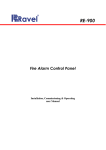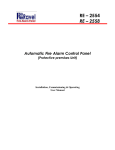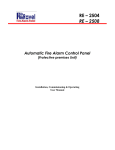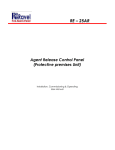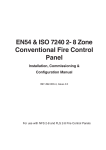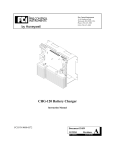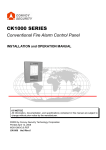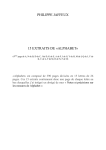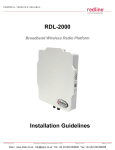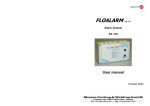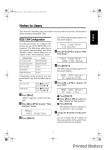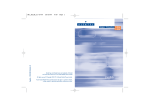Download Instruction Manual
Transcript
RE - 700 Fire Alarm Control Panel Installation, Commissioning & Operating user Manual Fire Alarm System Limitations An automatic fire alarm system–typically made up of smoke detectors, heat detectors, manual Call Points, audible warning devices, and a fire alarm control with remote notification capability–can provide early warning of a developing fire. Such a system, however, does not assure protection against property damage or loss of life resulting from a fire. The Manufacturer recommends that smoke and/or heat detectors are located throughout a protected premise following the recommendations of the current edition of the National Fire Protection Association Standard 72 (NFPA 72), manufacturer's recommendations, State and local codes, and the recommendations contained in the Guide for Proper Use of System Smoke Detectors, which is made available at no charge to all installing dealers? A study by the Federal Emergency Management Agency (an agency of the United States government) indicated that smoke detectors may not go off in as many as 35% of all fires. While fire alarm systems are designed to provide early warning against fire, they do not guarantee warning or protection against fire. A fire alarm system may not provide timely or adequate warning, or simply may not function, for a variety of reasons: Smoke detectors may not sense fire where smoke cannot reach the detectors such as in chimneys, in or behind walls, on roofs, or on the other side of closed doors. Smoke detectors also may not sense a fire on another level or floor of a building. A second-floor detector, for example, may not sense a first-floor or basement fire. Particles of combustion or "smoke" from a developing fire may not reach the sensing chambers of smoke detectors because: • Barriers such as closed or partially closed doors, walls, or chimneys may inhibit particle or smoke flow. • Smoke particles may become "cold," stratify, and not reach the ceiling or upper walls where detectors are located. • Smoke particles may be blown away from detectors by air outlets. • Smoke particles may be drawn into air returns before reaching the detector. 1 P/N RE – 700 Rev. No. 0 The amount of "smoke" present may be insufficient to alarm smoke detectors. Smoke detectors are designed to alarm at various levels of smoke density. If such density levels are not created by a developing fire at the location of detectors, the detectors will not go into alarm. Smoke detectors, even when working properly, have sensing limitations. Detectors that have photo electronic sensing chambers tend to detect smoldering fires better than flaming fires, which have little visible smoke. Detectors that have ionizing-type sensing chambers tend to detect fast-flaming fires better than smoldering fires. Because fires develop in different ways and are often unpredictable in their growth, neither type of detector is necessarily best nor may a given type of detector not provide adequate warning of a fire. Smoke detectors cannot be expected to provide adequate warning of fires caused by arson, children playing with matches (especially in bedrooms), smoking in bed, and violent explosions (caused by escaping gas, improper storage of flammable materials, etc.). While a fire alarm system may lower insurance rates, it is not a substitute for fire insurance! Heat detectors do not sense particles of combustion and alarm only when heat on their sensors increases at a predetermined rate or reaches a predetermined level. Rate-of-rise heat detectors may be subject to reduced sensitivity over time. For this reason, the rate-of-rise feature of each detector should be tested at least once per year by a qualified fire protection specialist. Heat detectors are designed to protect property, not life. IMPORTANT! Smoke detectors must be installed in the same room as the control panel and in rooms used by the system for the connection of alarm transmission wiring, communications, signaling, and/or power. If detectors are not so located, a developing fire may damage the alarm system, crippling its ability to report a fire. Audible warning devices such as bells may not alert people if these devices are located on the other side of closed or partly open doors or are located on another floor of a building. Any warning device may fail to alert people with a disability or those who have recently consumed drugs, alcohol or medication. 2 P/N RE – 700 Rev. No. 0 Please note that: o Strobes can, under certain circumstances, cause seizures in people with conditions such as epilepsy. o Studies have shown that certain people, even when they hear a fire alarm signal, do not respond or comprehend the meaning of the signal. It is the property owner's responsibility to conduct fire drills and other training exercise to make people aware of fire alarm signals and instruct them on the proper reaction to alarm signals. o In rare instances, the sounding of a warning device can cause temporary or permanent hearing loss. A fire alarm system will not operate without any electrical power. If AC power fails, the system will operate from standby batteries only for a specified time and only if the batteries have been properly maintained and replaced regularly. Equipment used in the system may not be technically compatible with the control. It is essential to use only equipment listed for service with your control panel. Telephone lines needed to transmit alarm signals from a premise to a central monitoring station may be out of service or temporarily disabled. For added protection against telephone line failure, backup radio transmission systems are recommended. The most common cause of fire alarm malfunction is inadequate maintenance. To keep the entire fire alarm system in excellent working order, ongoing maintenance is required per the manufacturer's recommendations, and UL and NFPA standards. At a minimum, the requirements of NFPA 72 shall be followed. Environments with large amounts of dust, dirt or high air velocity require more frequent maintenance. A maintenance agreement should be arranged through the local manufacturer's representative. Maintenance should be scheduled monthly or as required by National and/or local fire codes and should be performed by authorized professional fire alarm installers only. Adequate written records of all inspections should be kept. 3 P/N RE – 700 Rev. No. 0 NOTES: 4 P/N RE – 700 Rev. No. 0 5 P/N RE – 700 Rev. No. 0 Table of Contents CHAPTER 1: Introduction ………….......................……....................9 1.1: System Design & Planning............................................9 1.2: General .……….............................................................9 1.3: Fire Alarm Procedure …...............................................10 1.4: User Responsible .........................................................10 1.5: Routine test............…....................................………….11 CHAPTER 2: Product Description ...........................…….................12 2.1: Product Features .........................................................13 2.2: Specifications .........................................................…..14 2.3: Controls and Indicators ................................................15 2.3.1: LED Indication..........................................…………...15 2.3.2: Controls…………………………..….…………………..16 2.4: Mechanical Construction…………………………………17 CHAPTER 3: Installation .............................................……..........….18 3.1: Installation Precaution……………………………………18 3.2: Mounting Options .................................................….…21 3.2: Input Circuits.............................................................….22 3.3: Output Circuits .........................................................….23 CHAPTER 4: Programming Instructions ......................……........…24 4.1: Menu Key Flow Diagram...........................................…24 4.2: Programming…………………………….........................26 CHAPTER 5: Operating Instructions...….............……………..….....32 5.1: Switch Functions …………………….............................32 5.2: Status LED's.................................….........................…33 5.3: Operation..................................................................….34 5.3.1: Zone Fault ……………...............................................34 5.3.2: Zone Fire …………..............................................….. 35 5.3.3: Zone Disable / Test…………………………............... 36 5.3.4: System Supervisory……………………………………37 CHAPTER 6: Battery Calculation……………………………38 CHAPTER 7: Trouble Shooting……….…….….……………39 CHAPTER 8: Abbreviation……..….……………………….…40 6 P/N RE – 700 Rev. No. 0 Chapter 1: Introduction This manual is intended as a complete guide to the 8 Zone Conventional Fire Control Panel. User operating Instructions are provided in the first part of this manual. This is followed with sections describing installation and commissioning procedures and full technical details are provided. 1.1 System Design and Planning It is assumed that the system, of which this control panel is a part, has been designed by a competent fire alarm system designer in accordance with the requirements of IS 2189: 1988 and any other local codes of practice that are applicable. The design drawings should clearly show the positions of the field devices and the control equipment. 1.2 General The panel is self-contained with integral power supply and space provision for two sealed lead-acid standby batteries and comply with the requirements of IS 2189: 1988. The panels functions are microprocessor controlled and test and isolate functions are included. Provision is made for a repeater function of panel status output. The panel can accept, per zone, automatic detectors with a total maximum loading of 2.4mA quiescent current rating (refer to chapter 2.2), and an unlimited number of manual call points. End of Line (EOL) devices The panels can continue to monitor manual call points with detectors removed, providing the detectors are fitted with a Schottky diode and an EOL device is used. Installation The panel is easy to install and operate. Control functions Programming functions are enabled by using password. The panel fascias are retained by tamper-proof screws. 7 P/N RE – 700 Rev. No. 0 1.3 Fire Alarm Procedures In accordance with IS 2189: 1988, written procedures should be laid down for dealing with alarms of fire, fault warnings, and the isolation of any part of the system. The responsible person should ensure that users of the system are instructed in its proper use and are familiar with the procedures. On hearing the fire alarm: CARRY OUT THE PRESCRIBED PROCEDURE Subsequent actions will depend on the circumstances, and may include silencing the audible alarms and resetting the system, as described later. To Evacuate the premises: Press the Evacuate key and enter the password to OPERATE SOUNDERS. Fault Indication: If the control panel indicates a Fault condition, make a note of all illuminated indicators, refer to the chart on page 36, and call the engineer. 1.4 User Responsibility In addition to the routine testing described on routine test, the user has a responsibility for ensuring certain actions are taken following a fire or fault, and for implementing remedial action following a specified incidence of false alarms. As a minimum, the user shall record any incident and inform the service organization, who may be required to retest the system. The user's responsibilities are described fully in IS 2189: 1988. 8 P/N RE – 700 Rev. No. 0 1.5 Routine Testing In order to ensure that the system is fully operational, and to comply with the requirements of IS 2189: 1988, the following routine attention is recommended: Daily - Check the panel to ascertain that it indicates normal operation. If any fault is indicated check that it has been recorded and that the appropriate actions have been taken, e.g. informing the maintaining company. Weekly - Test at least one detector or call point to confirm the operation of the panel and the audible alarms. Test a different zone each week and, if possible, a different device. Keep a record of the device and zone tested each week. Record and report any malfunction. Quarterly - The responsible person should ensure that every three months the system is checked by a competent person. Check the standby batteries and the charger voltage Test at least one device in each zone to check the panel functions. Check the operation of the audible alarms and any link to a remote manned centre, Central Station, etc. Carry out a visual inspection of the installation to check for alterations or obstructions and issue a certificate of testing. Annually - The responsible person should ensure that, in addition to the quarterly checks, each device on the system is tested and that a visual inspection is made of the cable fittings and equipment. Note: The control panel case should be cleaned periodically by wiping with a soft, damp cloth. Do not use any solvents. 9 P/N RE – 700 Rev. No. 0 Chapter 2: Product Description The RE – 700 is a 2 – 128 zone microprocessor based conventional Fire Alarm Control Panel. The Panel accepts water flow devices, conventional input devices like 2 wire smoke detectors, pull stations and other normally open contact devices. The Outputs include notification appliance circuits (NACs / sounders), Two Form –C relays for Fire and one relay for fault. And also communication port RS485 to interface with remote annunciator. This panel is field programmable via the front panel keypad. It supervises all wiring, AC voltage and Battery level. 10 P/N RE – 700 Rev. No. 0 2.1 Product Features 2 - 128 Class B initiating device circuit (IDC / Zone Circuits). All zones accept smoke detectors and any normally open contact device. One Class B Notification Appliance Circuits (NAC / Sounder). Fully complies with IS 2189: 1988. Rugged CRCA sheet with powder coated finish. Modular construction. Operates on 220v, AC Mains power supply. Standby (battery) back up 24v DC power supply with built in charger Error free Fire / Fault status in unambiguous colored LED indication. 20 X 4 LCD Display. System ON indications. Main, Standby status with visual/audible indication. Battery Low visual warning with audible tone. Event storage with RTC. Form–C relays for Fire and fault. Lamp Test facility. Walk Test facility. Zone Isolation facility with loop voltage cut off. Compatible with all types of conventional detectors, Pull Stations and any normally open contact devices. 11 P/N RE – 700 Rev. No. 0 2.2 Specification AC Power 220 VAC, 50 Hz, +10%, -15%. Wire size: 1.5 Sq. mm with 600 V insulation Battery (Lead Acid only) Charging Current: Constant Voltage – 27.6v @ 0.8A (Max.). Charging Capacity: 7 Amp Hour Battery (Higher size are request). System Quiescent Current: 50mA + (4.4 – 6.8mA per zone) Initiating Device Circuits (Zone Circuit) All zones are Class B operation Normal Operating Voltage: Nominal 24 VDC Alarm Current: 15 – 35mA threshold Short Circuit Current: 40mA Maximum Loop resistance: 100 ohms Maximum End-Of-Line Resistor: 4.7K, 1/4watt Standby Current: 8.2mA (4mA for Detectors) Notification Appliance Circuits (Sounder Circuit) Class – B wiring Operating Nominal Voltage: 24 VDC Current for all NACs: 0.2A per Zone End-Of-Line Resistor: 4.7K, 1/4watt Three Form – C Relays Relay Contact Rating: 2Amps @ 30 VDC, 2Amps @ 30VAC. 24 VDC Power Operating Voltage: 24VDC, 500mA Max. RS485 Communication Port Max. Distance: 1.5Km Max. 12 P/N RE – 700 Rev. No. 0 2.3 Controls and Indicators 2.3.1 LED indication System On – Green A.C On – Green Battery On – Green Charger On - Green Low Battery – Yellow Hooter Fault – Yellow AUX. Isolate – Yellow CPU Fault – Yellow Silence – Yellow Zone Fire – Red Zone Fault – Yellow Zone Isolate – Yellow Local Buzzer A piezo buzzer provides separate and distinct sounds for alarm, trouble and supervisory conditions: Alarm – steady Fault – pulse 0.5sec ON and 1sec OFF 13 P/N RE – 700 Rev. No. 0 2.3.2 Controls: SILENCE: During fire/fault condition, silence is used to silence the external Sounders (NAC) and the internal buzzer tone is changed from continues tone to toggle tone in fire condition and also used to silence the continues internal buzzer tone in fault condition. RESET: This key is pressed to reset the entire system and all detector loop voltages are cut off up to 3 seconds for Detectors and MCP’s, Then voltages are put on to the loop only during fire condition. EVACUATE: This key is used to energize the external hooters without actual fire. CURSER KEYS: These keys are used to move the curser point wherever required. ENTER: This key is used to accept given input to the Panel which is given by the user from program menu like Disable zone number, location name, password entering when we should use ENTER key for input termination. PROGRAM: This key is used to enter into the programming mode for changing the zone details other setting. The configuration changing is done in level 2(requires Password). The various steps involved in this program are shown as flow chart shown in the chapter 4. LAMP TEST: This key is used to enter into the lamp test mode for checking the all the LED conditions. 14 P/N RE – 700 Rev. No. 0 2.4 Mechanical Construction The enclosure of the Panel is constructed by 16 gauge (1.07mm) CRCA sheet with powder-coated (1.14mm) finish. The ∅19mm knockouts are given for cable entry at the top of the cabinet. The panel also has sufficient space to accommodate 2 Nos. of 12v, 7Ah batteries. The front side of the panel consists of the following, which is shown in chapter 1.3. a. b. c. 20 X 4 LCD Dot Matrix display module. Tactile switches. LED Indicators 15 P/N RE – 700 Rev. No. 0 Chapter 3: Installation 3.1 Installation Precaution Installation Precautions WARNING - Several different sources of power can be connected to the fire alarm control panel. Disconnect all sources of power before servicing. Control unit and associated equipment may be damaged by removing and/or inserting cards, modules, or interconnecting cables while the unit is energized. Do not attempt to install, service, or operate this unit until this manual is read and understood. CAUTION - System Reacceptance Test after Software Changes. To ensure proper system operation, this product must be tested in accordance with NFPA 72 after any programming operation or change in sitespecific software. Reacceptance testing is required after any change, addition or deletion of system components, or after any modification, repair or adjustment to system hardware or wiring. All components, circuits, system operations, or software functions known to be affected by a change must be 100% tested. In addition, to ensure that other operations are not inadvertently affected, at least 10% of initiating devices that are not directly affected by the change, up to a maximum of 50 devices, must also be tested and proper system operation verified. This system meets NFPA requirements for indoor dry operation at 0-49° C/32-120° F and at a relative humidity of 93 ±2% RH (non-condensing) at 32 ±2° C/90 ±3° F. However, the useful life of the system's standby batteries and the electronic components may be adversely affected by extreme temperature ranges and humidity. Therefore, it is recommended that this system and all peripherals be installed in an environment with a nominal room temperature of 1527° C/60-80° F. 16 P/N RE – 700 Rev. No. 0 Verify that wire sizes are adequate for all initiating and Indicating device loops. Most devices cannot tolerate more than a 10% I.R. drop from the specified device voltage. Adherence to the following will aid in problem-free installation with long-term reliability: Like all solid-state electronic devices, this system may operate erratically or can be damaged when subjected to lightninginduced transients. Although no system is completely immune from lightning transients and interferences, proper grounding will reduce susceptibility. Overhead or outside aerial wiring is not recommended, due to an increased susceptibility to nearby lightning strikes. Consult with the Technical Services Department if any problems are anticipated or encountered. Disconnect AC power and batteries prior to removing or inserting circuit boards. Failure to do so can damage circuits. Remove all electronic assemblies prior to any drilling, filing, reaming, or punching of the enclosure. When possible, make all cable entries from the sides or rear. Before making modifications, verify that they will not interfere with battery, transformer, and printed circuit board location. Do not tighten screw terminals more than 9 in-lbs. Over-tightening may damage threads, resulting in reduced terminal contact pressure and difficulty with screw terminal removal. Though designed to last many years, system components can fail at any time. This system contains static-sensitive components. Always ground yourself with a proper wrist strap before handling any circuits so that static charges are removed from the body. Use static-suppressive packaging to protect electronic assemblies removed from the unit. Follow the instructions in the installation, operating, and programming manuals. These instructions must be followed to avoid damage to the control panel and associated equipment. FACP operation and reliability depend upon proper installation by authorized personnel. 17 P/N RE – 700 Rev. No. 0 3.2 Mounting Options Place the panel in its mounting position and fix the panel to the wall using the slots of the four screws. Ensure the enclosure and the inner parts of the panel are given sufficient protection during installation. All external cables are to be entered via the ∅19mm preformed knockouts located at the top of the panel. When the installation of all the cables has been completed, clean the interior of the enclosure ensuring all masonry debris and drilling swords are removed. 18 P/N RE – 700 Rev. No. 0 3.3 Input Circuits The control panel has 2 – 128 zone input circuits. The maximum loop resistance limit for each input circuit is 100 ohms. All field wiring of each zone is supervised for opens and ground faults. Both conditions are visually and audibly (toggle tone) annunciated. Each zone is a Class B Initiating Device Circuit (IDC – Zones) designed to accept any normally open contact devices and conventional 2-wire, 24 volt smoke detectors. It is allowable to mix an assortment of device types (i.e. smoke detectors, heat detectors, pull stations, etc.) on any zone. 19 P/N RE – 700 Rev. No. 0 3.4 Output Circuits Nonresettable Power (500mA) 24 VDC filtered, nonresettable power can be obtained from 24v DC out Terminals. Sounder Circuits The RE - 700 provides Notification Appliance Circuits (NAC) standard as Class B. This circuit is capable of a maximum of 0.2 amps of current per zone. 20 P/N RE – 700 Rev. No. 0 Standard Relay The control panel provides three Form-C relays rated for 2.0 amps @ 30 VDC and 2.0 amps @ 30 VAC. Relay connections may be power-limited or nonpower-limited, provided that a minimum of 0.25" is maintained between conductors of power-limited and nonpower-limited circuits. 21 P/N RE – 700 Rev. No. 0 d CHAPTER 4: Programming Instructions 4.1 Menu Key Flow Diagram: PROGRAM KEY - FLOW DIAGRAM PROGRAM Admin / User Password 1 2 3 M ENU HISTORY ABOUT 1 3 2 Isolate Mode Test Mode 1. V iew Events 2. Dele te All Eve nts Settings 2 1 1. Self Test 2. Walk Test 1. Zone Isolation 2. Aux Isolation 3. Sounder Isolation 1. Location Program 2. Date & Time 3. Password & Logo 4. Onsite Config. 1. V iew All Even ts 2. A larm Eve nts 3. Z one Fault Eve nts 4. P ow er Fault Events 1 1 System In Self Test Mode Zone Isolation 1 Enter Zone No.? Location Name Editor Enter Zone No: 1 Evn No: [ xx/xx] Date : dd/mm/yy Time : hh:mm Ev t : Type of e v ent 2 2 Aux Isolation 1. Self Test 2. Walk Test Aux Normal Press'#' to Chge S ounder Iso lation 1. Common S ounder 2. Zone W ise Sounder 1 Sounder Isolation Comm Sound Normal Press'#' to Chge 3 Logo Name Editor Logo Name: RAVEL ELECTRONICS Date & Time Editor 2 Date: DD/MM/YY Time : HH:MM PA SSWORD? 1. Use r Password 2. Admin Password 3. Logo 3 RAVEL ELEC TRONICS M odel: RE-700 Vers io n: 1.2 3 1&2 Password Editor Old Password? 4 Password? 2 Sounder Isolation Comm Sound Normal Press'#' to Chge Password Editor New Password? Password Editor Re-Type New? Password Editor Re-Type New? ***** New Password updated Press '#' to chge Note: 1. Default Admin Password: 54321 2. Default User Password: 12345 3. Program using user password can access only for Test Mode. 4. To Delete the Event history. 22 P/N RE – 700 Rev. No. 0 4.2 Programming: The PROGRAM key is used to enter into the programming mode for changing the zone details other setting using admin password and to view the history (Events) of the panel. The display shows as following after pressing the program key. 1. Menu 2. History 3. About 4.2.1 Menu: Menu is accessed by both user and admin, but user can enter into test mode only using user password. The configuration changing is done using admin password. The various steps involved in this menu are shown as flow chart. After entering into the menu, screen will shown as follows, 1. Isolation Mode 2. Test Mode 3. Settings 4.2.1.1. Isolation Mode: In this mode, isolation is done for the Zones, AUX and Sounder. When entered into this mode the screen Shows as follows. 1. Zone Isolation 2. Aux Isolation 3. Sounder Isolation 4.2.1.1.1 Zone Isolation: By selecting the number 1 in the keypad from Isolation mode screen, it enters into the zone isolation screen. It is shown as below: Zo ne Isolation Enter Zone No .? 23 P/N RE – 700 Rev. No. 0 The zone, which has to be isolate, is entered, and then the ENTER KEY is pressed. The isolate LED will glow and corresponding zone loop voltage will get cut off. Then screen will show as that particular zone is isolated. Press ”#” to continue. After pressing “ # ”, it will ask for disable for next zone. To come back to main screen press “ * “ key till you get main screen. Note: a. We strongly recommend avoid to disabling any particular zone unless it is giving any false alarm / Fault Condition / Reworking. b. For zone disabling and their normalization, use same procedure as for the disable. 4.2.1.1.2 Aux Isolation: By selecting the number 2 in the keypad, it enters into the Aux Isolation screen. It Displays as follows. Aux Isolation Aux Normal Press '#' to Chge Then the screen will show that Fire Relay Output status (NORMAL). Then press ”#” to change the present Condition. 4.2.1.1.3 Sounder Isolation: By selecting the number 3 in the keypad, it enters into the Sounder Isolation screen. It displays as below. Sounder Isolation 1. Common Sounder 2. Zone wise Sounder Sounder, which is to be isolate, is selected by the corresponding number from the key board, then display changed as shown below. 24 P/N RE – 700 Rev. No. 0 Display for Common Sounder Isolation: Sounder Isolation C omm Sound Normal Press '#' to c hge Display for Common Sounder Isolation: Sounder Isolation Z W Sound Normal Press '#' to chge Then screen will show as that particular NAC is disabled. Then press ”#” to change. To go back to main screen press “ * “ key till you get main screen. 4.2.1.2. Test Mode: By selecting the number 2 in the keypad from menu screen, it enters into the Test Mode screen. It shows as follows. By using appropriate number in key pad test mode is selected. 1. Self Test 2. Walk Test 4.2.1.2.1 Self Test: By selecting the number 1 in the keypad from test mode menu, it enters into the Self Test Mode screen. It shows as follows. In self test mode, the zone module in the panel are tested automatically SYSTEM IN SELF TEST MODE 4.2.1.2.2 Walk Test: By selecting the number 2 in the keypad from test mode menu, it enters into the Walk Test Mode screen. It shows as follows. 25 P/N RE – 700 Rev. No. 0 WALK TEST MODE The RE – 700 provides the capability to perform a walktest of the system without triggering the Fire Relay. Walk test Mode allows for testing of all the zones. For a walktest, the initiating device activated on a zone will cause the Notification Appliance Circuits (Sounder/Hooter) to turn on for three seconds. Any smoke detectors that are activated will be reset automatically after 6 seconds. Placing the control panel into Walktest Mode will be possible only if the system has no active alarms. After entering into the walktest mode, the fire relay contact disablement is activated automatically and it will go back to previous status while we are coming out from this mode. This feature helps to perform the testing of devices by a single person. In this mode if the panel detects any fire then after 3 seconds the panel will get automatically silenced. After 6 seconds of silence, the panel will go to reset. This reset is done for only that particular zone. Once in Walktest Mode, the control panel will immediately: • • • • • Disable the fire relay. Display all alarm conditions as they occur. Display all zone troubles as they occur. Display all system troubles as they occur. If fire is created, turns on the Notification Appliance Circuits for 3 seconds for alarm on a zone. 26 P/N RE – 700 Rev. No. 0 Note: a. The maintenance person should enter into the walktest mode in normal condition of the panel. b. If there is no more testing, ensure that the zone is brought back to the normal Condition. c. During in this mode, the Potential free Relay will not be activated while in fire condition. d. If there is no more testing for 10 minutes, the panel return back to normal mode automatically. 4.2.1.3. Settings: By selecting the number 3 in the keypad from menu screen, it enters into the Setting Mode screen. It shows as follows. In this mode entering the corresponding number we can change the following thinks. 1. Location Program 2. Date & Time 3. Password & Logo 4. Onside Config 4.2.1.3.1. Location Program By selecting the number 1 in the keypad from setting menu, it enters into the location Mode screen. It shows as follows. When entering into this it will ask the zone number. After entering the zone number press ENTER key, cursors goes to next line. Then enter the location using the number / letter key pad, press ENTER key after entering location. Lo cation Name Edito r E nter Zone No: The display showed as below. It will stay in location entering mode to continue location entering, so to go back press ‘*’ key. 27 P/N RE – 700 Rev. No. 0 4.2.1.3.2. Date & Time By selecting the number 2 in the keypad from setting menu, it enters into the date & Time change Mode screen. It shows as follows. In this mode we can change the date and time of RTC (Real Time Clock) by using the keypad. The display will show as below. Date & Time Editor Date : DD/MM /YY Tim e : HH:MM When entered into this mode curse blinks on the date, you can change the date by using number / letter key pad. Then press ENTER key to go to change the time, then again press ENTER key to set the date & time. 4.2.1.3.3. Password & Logo When you press number 3 in the keypad from setting menu, it enters into the password & logo change mode. In this mode, user and admin password can be changed and logo name can be edited. The Display will show as below. 1. User Password 2. Admin Password 3. Logo Name 28 P/N RE – 700 Rev. No. 0 4.2.1.3.3.1. User & Admin Password: In this mode, the User and Admin password can be changed by pressing the key 1 and 2 from the keypad respectively. When entered into the change mode, the following instructions have to be followed. The password should be 5 digit. Default Password for ‘User’ Level – ‘12345’ Default Password for ‘Admin’ Level – ‘54321’ Password Editor Old Password? XXXXX Password Editor New Password? XXXXX Password Editor Re-Type New ? XXXXX Password Editor Re-Type New ? XXXXX New Password Updated Press ' # ' to Ctue 29 P/N RE – 700 Rev. No. 0 4.2.1.3.3.2. Logo Name: When you press number 3, then it goes into LOGO change mode. It gives the screen like this. Logo Name Editor Logo N ame: RAVEL ELECTRONICS The cursor gets starts blinking, then over write the new logo name on old logo name and press ENTER key to conform the correction. It will go to previous screen i.e. main screen of the password & logo change mode. 4.2.1.3.4. Onsite Configuration This section is used for panel up-gradation on the site. This section is protected from end users by password, only our service engineers can access it. 4.2.2 History: In this mode, the history that is events of all functions of the zone loop and other functions happened in the panel can be viewed at level 0 (Password not required). Enter into History mode by pressing number 2 from the program menu, which is given below. 1. Menu 2. History 3. About 4.2.2.1 View Events: When you press number 1, then it goes into sub menu. Like given below. 30 P/N RE – 700 Rev. No. 0 1. 2. 3. 4. View All Ev ents Alarm Events Zone Fault Events Pow er Fault Events By pressing corresponding number you can see details corresponding events. For example the alarm events can be viewed by pressing 2 from this menu, display is as shown below: EvtNo: [X/Y] Date : DD/MM/YY Time : HH:MM Evt : FIRE-ZONE A 4.2.2.2 Delete All Events: This menu option is used to delete all exist events in the storage memory. During this menu selection by pressing 2, first it will wait for your password (Admin Password), if the password is correct then the display shows as follows: Delete All Events? '#'-Yes '*'-Back CAUTION: Deleted Evts can't recover back Press ‘#’ to delete all the events else press ‘*’ to come back. 4.2.3 About: It shows the details of the panel by pressing number 3 from the main menu. The LCD will show as below. Ravel Electronics Model: RE - 700 Version: 1 .2 31 P/N RE – 700 Rev. No. 0 Chapter 5: Operating Instruction 5.1 Switch Functions The Keys, which are non-masked, are used for the general operation of the Fire Alarm Panel. The Non-masked keys are Silence, Reset, Ack., Evacuate and Enter keys. SILENCE Key: This key is used in Fire / Fault Condition. To acknowledge the external sounder / internal buzzer press this key. And the internal buzzer tone is changed from continues tone to toggle tone for fire condition. RESET Key: This key is also used in only Fire Condition. The panel is reset by pressing this key and during reset condition, all the detector input voltages are cut off up to 3 seconds for Detectors and MCP’s, Then voltages are put on to the loop. LAMP TEST Key: This key is used to check the all LED’s in panel is in good condition with continues buzzer tone. 32 P/N RE – 700 Rev. No. 0 EVACUATE Key: This key is used to energize the external hooters without actual fire. ENTER KEY: This key is used to accept the password during silence, reset in Fire Condition And also used for the Evacuate. 5.2 Status LED: Normal: In the Normal Condition, SYSTEM ON, A.C. ON, CHARGER ON green LED will be illuminated. There should be no other amber / red LED visual indication or audible tone. A.C ON: Whenever the Main Supply (220v A.C) fails / fuse blown, the Mains fail LED will be shut off and it also indicated in LCD with toggle Buzzer tone. BATTERY ON: Whenever the backup battery fails / fuse blown, the battery fault LED will be shut off and it also indicated in LCD with toggle Buzzer tone. LOW BATTERY: Whenever the backup battery voltage goes below the 21v, the low battery LED will be illuminated and it also indicated in LCD with toggle Buzzer tone. CPU FAIL: For feature development. AUX ISOLATE: When the AUX Output is disabled, then the AUX isolate LED will be illuminated. HOOTER FAULT: Whenever there is any fault in Notification Appliances Circuits like Hooter loop Open / Short, it will be identified by COMMON HOOTER FAULT LED. 33 P/N RE – 700 Rev. No. 0 5.3 Operation 5.3.1 ZONE FAULT: When faults like Open/ Short occurred in the loop, the corresponding ZONE FAULT LED would identify it. During above condition LCD Show as follows and by using the curser key the suppressed fault can be viewed. [A/B] OPEN /SHORT IN ZONE X Zone Location Where A – nth Fault; B – Total No. of Fault; X – Zone Number which is shown in LCD at present Note: During the above fault conditions, apart from the specific fault identification LED, common fault, common fault relay and Local buzzer with intermittent tone will be activated. During this time, if ‘ACK.’ is activated, intermittent tone will be silenced. By using ‘*’ key type of hidden fault can be viewed. 5.3.2 FIRE: When the control panel detects Fire via the Detector / MCP, the corresponding ZONE FIRE red LED will be illuminated. At the same time hooter, potential free contact and local buzzer (continuous tone) will be activated. The common Fire LED will illuminate whenever any zone is goes to fire condition. The LCD shows as follows. If there is more than one fire, the number of zones in fire (shown as (Z##)) and in which zone first or recent fire (Shown as Z##) occurred will be displayed on the fire screen. [A/B] FIRE IN ZONE X Zone Location 34 P/N RE – 700 Rev. No. 0 Where A – nth Fire; B – Total No. of Fire; X – Zone Number which is shown in LCD at present The External hooter will be silenced by using the Silence Key and silenced LED indicates it. But the buzzer tone will change to toggle tone from continues tone. Always the recent fired zone FIRE LED will blink continuously, rest of the fired zone FIRE LED’s will glow constantly till it goes to RESET. The FIRE LED indication will remain ON condition till the panel is RESET. Note: 1. The Fire and Fault relay will be in ON condition till the fire and fault LED’s go OFF. 2. By silencing, hooters are switched off and relay output for actuators will remains in ON Condition until reset. 3. Always Recent fire zone LED will blink. 4. The other fire zones can viewed by using the key ‘*’. 4.3.3 ISOLATION: There are three types of disablements as given below. a. Zone Isolation b. Aux Isolation c. Sounder Isolation The Zone Isolation is done in access level 2. The corresponding Isolation LED identifies the zone, which isolated. The ON status indicates, the zone is Isolated from the monitoring with its loop voltage being cut off. The OFF status indicates the zone is in monitoring condition. Others AUX output Isolate is shown by separate LED. Note: a. If there is no more testing please ensure that the zone is brought back to the normal Condition. b. During in this mode, the Potential free Relay will not be activated while in fire condition. 35 P/N RE – 700 Rev. No. 0 5. Battery Calculation: Battery Calculation: Normal Condition: X = Quiescent Ct. (Amps) x ____ Hrs. Alarm Condition : Y = Alarm Ct. (Amps) x ____ Hrs. Sum of Standby and Alarm Ah: Z = X + Y Battery size required in Ah = De-rating Factor x Z. Example: Battery Calculation for 24 Hrs. Back up (RE – 2508) Normal Condition: X = 0.08 x 24 Alarm Condition: Y = 2 x 1 Sum of Standby and Alarm Ah: Z = 1.92 + 2 = 3.92 Battery size required in Ah = 1.2 x 3.92 = 4.704 36 P/N RE – 700 Rev. No. 0 6. Troubleshooting Indication Root Cause There is no indication on the panel If there is any false alarm from the detector No power to the Panel Detector OPEN is not detected by the panel Total zone loop current exceed the rated value Hooter fault indication There is no proper connection in the hooter Or loop Fault. May be the detector is faulty or check EOL resistor Connection Details for Non Polarized Hooter Diode IN4007 + + Hooter (NAC) - - 37 Remedy Check AC power and Standby power. Ensure the AC supply within 220v±10% (or) Change the faulty detector Check number of detectors connected in the loop. Total detectors current should not go above 2.5mA If there is no hooter connected to the output, check if EOL resistor connected there or not. Check loop wiring for short / open using a meter. If hooter is nonpolarized, then ensure each hooter’s +ve loop is connected to 1N 4007 diode’s cathode and the hooter –ve loop connected to the anode of 1N 4007. P/N RE – 700 Rev. No. 0 7. Abbreviation The short forms, which are given in this manual, are abbreviated below, RE EN-54 NFPA AC DC CRCA LED O/P IP 54 mm no(s). v Ah IEE EOL PCB CPU MCP S.No mA Kgs C,NO,NC - Ravel Electronics Pvt Ltd., European Standard National Fire Protection Association Alternating Current Direct Current Cold Rolled Carbon Alloy Light Emitting Diode Output Industrial Protection millimeter number(s) volt(s) Ampere per hour Institute of Electrical Engineering End Of Line Printed Circuit Board Central Processing Unit Manual Call Point Serial Numbers milli Ampere kilo grams Common, Normally Open, Normally Close. 38 P/N RE – 700 Rev. No. 0 RAVEL ELECTRONICS PVT. LTD No. 150-A, Elec. Indsl. Estate, Perungudi, chennai – 600 096. India Tel.: 24961004 / 24960825 Fax: 044-4204 9599 Email: [email protected] Web: www. ravelfirepanels.com DATE: TEST CERTIFICATE This is to certify that the following items are tested and checked. Microprocessor Based Conventional Fire Alarm Control Panel. Model No.: RE - 700 Serial No.: No. of zones: For RAVEL ELECTRONICS PVT.LTD, Q.C. – Engineer Tested By 39 P/N RE – 700 Rev. No. 0 RAVEL ELECTRONICS PVT. LTD No. 150-A, Elec. Indsl. Estate, Perungudi, chennai – 600 096. India Tel.: 24961004 / 24960825 Fax: 044-4204 9599 Email: [email protected] Web: www. ravelfirepanels.com WARRANTY CERTIFICATE Model No.: RE - 700 Serial No.: Ravel Electronics warrants each product to be free from defects in material and workmanship. This obligation is limited to servicing or part returned to the company for that purpose and making good any parts thereof which shall be within warranty period, returned to the company under a written intimation and which to the company’s satisfaction to be found defective. The company reserves the right to decide the workplace for the repair work. The freight for defective material will have to be borne by the purchaser, and the transit risk for such material will rest with the purchaser. This warranty will last for a period of 12 months from the date of Invoice of the product from the factory. The warranty is applicable only if the product is used within its specifications. The warranty for the replaced components will lapse along with that of the main product. THIS WARRANTY IS VALID UP TO: 12 months from the date of invoice Authorised Signatory 40 P/N RE – 700 Rev. No. 0











































